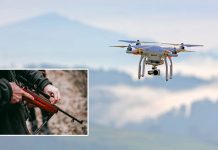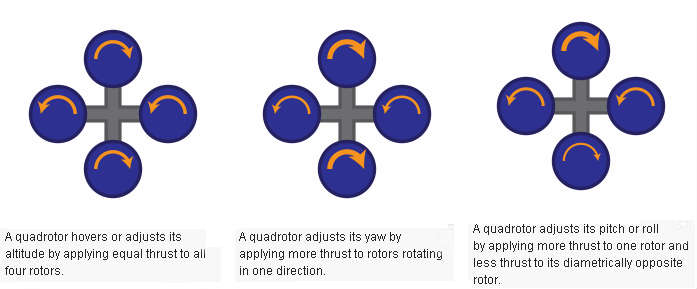
Convertawings quadrotor, Long Island March 1956. Image source: Wikipedia
Drones and quadcopters have revolutionised flight. They help humans to take to the air in new, profound ways. Today’s drones and quadcopters come with mind-blowing capabilities, flight being the least of these. These nifty devices capture dazzling aerial images and enable augmented reality game playing as well.
They can go to places humans cannot, enabling them to do much more than thought possible.
How these devices developed over the decades is fascinating. Their aerodynamic features and uses pique curiosity.
A. What is a drone/quadcopter?
Drones belong to a class of aerial vehicles known as Unmanned Aerial Vehicles (UAVs). These vehicles can take to the air without pilots.
Essentially, this makes drones flying robots. Encompassing both planes and quadcopters, they have software-controlled flight plans integrated into their systems. These systems work with Global Positioning Technology (GPS) to guide and track their movements.
The quadcopter is a newer UAV. As its name suggests, this rotorcraft (a craft lifted by spinning rotor blades) depends on four quick-turning rotors to give it thrust. Two spin clockwise and the other two, counter-clockwise. Two sets of identical, fixed pitch propellers help the process. Pilots achieve control of the craft by using remote control transmitters to change the speed of its rotor discs.
B. The history of Unmanned Aerial Vehicles
Drones and quadcopters have a rich history. With the help of advanced computer technology and engineering, they have developed in stunning ways.
1. Why were UAVs constructed?
Military in different countries first used drones for war. The Austrian military first developed these devices for combat purposes. In 1849, the Austrians first attacked Venice, in Italy, with unmanned air balloons filled with explosives. Some of these worked, while the wind blew others back into Austrian territory. Though not as technologically sound as today’s UAVs. they showed potential.
Planes with no pilots appeared after World War 1. The Hewitt Sperry Automated Airplane, developed by Elmer Sperry of the Sperry Gyroscope company, was the early version of today’s aerial torpedo.
The American military soon turned Standard E-1 planes into drones. One of them, the Larynx, was a little monoplane that could fly on autopilot after being launched from a warship. Other automated aircraft, developed by the US and British military, soon followed.
The first mass-produced airplane was the brainchild of Reginald Denny. A successful Hollywood actor, he pursued his interest in remote-controlled drones and formed Reginald Denny industries. The company produced the radio plane, which he enhanced for the American military in World War 2.
The US military experimented with these remote-controlled drones and built a variety of aerial torpedoes. They used these craft as target drones during the Cold War. These drones were capable of collecting radio-active data as well.
2. The first quadcopters
Quadcopters were among the first vertical take-off and landing vehicles (VTOLs).
Earlier helicopters used tail rotors to counterbalance the torque, or rotating force, generated by a single, main rotor. This was wasteful and inefficient.
Engineers developed quadcopters to solve the problems that helicopter pilots had with making vertical flights. The first was the Omnichen 2, invented in 1920 by Etienne Omnichen.
De Bothezat Helicopter, 1923. Image source: Wikipedia
This craft made 1000 successful flights and flew a recorded distance of 360 meters (1181.1 feet).
The Convertawings Model A quadcopter. designed by Dr. George E Bothezat, appeared in 1956. It was the first to use propulsion, or a propeller’s forward thrust, to control an aircraft’s roll, pitch and yaw. The Curtis Wright V27, developed by the Curtis Wright Company, followed in 1958.
3. Current developments
Technology has advanced quadcopters dramatically. In the past decade, companies like DJ Innovations, Parrot, Walkera, Blade and Heli-Max have launched mini quadcopters that use state-of-the-art computer technology for flight control and aerial photography.
C. Quadcopters best features
Remote-controlled quadcopters have qualities that make them popular among enthusiasts. They gain new ones every day.
1. Quadcopters incorporate the features of pitched and co-axial helicopters
Quadcopters have the qualities of different helicopters. Helicopters are either pitched or co-axial. While pitched ones are agile and wind resistant, co-axial ones, which depend on two layers of rotors, are more stable. Quadcopters are a comfortable blend of both. Three-axis gyro technology enhances their stability.
Agile, yet steady, they are ideal vehicles for aerial photography.They carry aerial cameras and gimbals to make this possible.
2. Remote-controlled transmitters
Pilots control the quadcopter with the joysticks on a remote-controlled transmitter. A receiver on the quadcopter processes the pilot’s instructions. The pilot’s signals combine with output from the quadcopter’s altitude sensors. The flight controller then signals the Electronic Speed Controllers (ESCs), which in turn move the quadcopter’s motors.
3. Different aerodynamics from an airplane
A quadcopter uses different aerodynamics from an airplane for flight.
Newton’s law of motion states that for every action, there is an equal and opposite reaction. The four rotors, two moving clockwise and the other two, counter-clockwise, negate any force or torque on the fuselage. They stabilize movement and function.
Conversely, a typical helicopter’s single rotor, which rotates clockwise, forces the fuselage to move counter-clockwise. The resulting torque puts pressure on it and makes it vulnerable.
Flight control. Image source: Wikipedia
4. Relies on a strong center of gravity
The quadcopter’s center of gravity (CG), in the middle of its four rotors, keeps it balanced. Putting loads on it may affect the CG and hence, stability, but pilots can adjust the helicopter’s load to counteract this.
5. Simple design
A quadcopter’s simple design wins over many pilots. They do not come with long shafts, unlike helicopters. These are difficult to align.
D. Quadcopter uses and applications
A quadcopter is not merely a pilot’s flying toy. It has other beneficial uses as well. Researchers are constantly looking for ways to harness their capabilities.
1. Ways to use quadcopters
a. Research
University researchers, who work in various fields, use the quadcopter as a research tool. They gather information needed for work on robotics, flight control and real-time systems.
Quadcopters make suitable test platforms, as they are relatively cheaper and smaller. Anyone can fly them, which makes them convenient tools for researchers.
Apart from this, these durable little devices can survive harsh environments. They can go into dangerous places on behalf of researchers. This helps solve many difficulties with cost and logistics.
b. Military, law enforcement and community agencies
Military scientists in different countries invented quadcopters for combat and reconnaissance purposes. They still serve these functions.
Law enforcement agencies use them in search and rescue operations as well. These little aerial vehicles scour inaccessible areas for disaster survivors. Agencies also use them to uncover criminal activity. One of these drones is the Aeryon Scout, developed by Canadian Company Aeryon Labs. It has helped uncover drug trafficking rings in Central America.
c. Commercial use and aerial photography
Amateur pilots and enthusiasts love quadcopters as their dazzling aerial stunts make excellent conversation topics.
These days, many use them to capture aerial images and videos. Three-axis gyro technology stabilises many of the latest quadcopters, allowing them to capture these images without a shaky, “jello” effect.
Expert pilots regard Go Pro cameras as the best ones to use with quadcopters. Pilots of Walkera, Blade and DJI quadcopters can make use of their Go Pro cameras, the Go Pro channel and the Go Pro application on the smart phones. They can easily attach these cameras to their quadcopters for filming. The DJI Phantom Vision 2 and the DJI Phantom 2 Vision Plus have wonderful filming capabilities. Three-axis gimbals allow them to capture smooth videos. Pilots can capture more stunning images by loading quadcopters with Go Pro cameras.
The Blade 350 QX, too, works well with a Go Pro camera. This little quadcopter, unlike others, has an agility mode for advanced flying. This nimble device works well with Go Pro cameras like the Go Pro Hero 3 and can capture images from many perspectives.
Walkera is another company that produces quadcopters that work in tandem with Go Pro cameras. The Walkera Scout X4 and X800 already have excellent cameras, but they can carry the Go Pro Hero 3 to capture excellent aerial images.
d. Augmented Reality Games
Apart from being able to use them with cameras, pilots can play augmented reality games with their quadcopters as well. Augmented reality gives them a perspective of the real world, with a few thrilling enhancements. The real-world simulation makes the games enticing for older children and teens.
Mission Helicopter is one such game. Pilots simply need to push items through obstacle courses without “blowing up” their quadcopters. Ideal for younger players, the graphics are eye-catching and the controls, easy to manipulate.
Helicopter Game is another AR game that works the same way. Pilots have to move objects through obstacle courses without blowing their quadcopters up. This game, however, has more unpredictable controls. Teens and adults will find it a challenge to move objects without damaging their quadcopters.
In Secure the Deck, players have to storm the deck of the ship. They have to push troops on glowing pads so that they can take the ship’s deck over. The task sounds simple, but players face the challenge of high seas that will cause men to go overboard.
In Helic, a shoot-to–kill game, players have to protect turrets from enemy attacks. While the turret serves as a launching pad for missiles and bullets, players should shoot the enemy themselves.
2. The future evolution of quadcopters
Quadcopters already have extensive uses. Researchers have already discovered ways to stretch their potential.
a. Solving problems with motion
Athletes and those with disabilities often encounter problems with movement. Quadcopters may help ease their burdens.
Raffaella D’Andrea, a scientist at Ted Global, explained how quadcopters can complete difficult, physical tasks human beings cannot. In a demonstration, he balanced a wine glass filled with water on top of a quadcopter. The device flew without spilling water out of the glass. The high speed of the quadcopter negated the aerodynamic effects and gravitational pull on the water. What helped further was that the quadcopter’s propellers pointed upwards, in the same direction as the glass.
Such findings help athletes, who can develop greater speeds and better posture to overcome problems with gravity and aerodynamics.
b. Delivering food and medicine
Quadcopters, being minute, can reach places humans cannot. In future, community agencies may use them to deliver food and medicine to inaccessible areas where roads are completely cut off. Andreas Raptopoulous, a researcher at Matternet, explained how the quadcopter can transport about 2Kg (4.41 pounds) of medicines to these areas in about 15 minutes. He introduced Matternet, a system of flying vehicles and landing stations, controlled by routing software.
Quadcopters can navigate into ground stations, in safe areas, to deliver food and medicine. The routing software guides the quadcopters through adverse weather. This will help people in hard-to-reach areas recover and progress.
c. Conservation
Governments and environmental protection agencies can tap into the aerial imaging capabilities of quadcopters for environmental conservation. Ecologist Lian Pin Koh explained how conservation quadcopters can go over landscapes and capture images on the ground without causing disturbance. Able to capture wildlife habitats in remote areas, conservation quadcopters capture information that tells these agencies if wildlife is under threat. They also drastically decrease conservation costs.
E. Conclusion
Drones and quadcopters, with extensive history and capabilities, are the devices of the future. In time to come, humans will find it difficult to imagine life without them.



























This site was… how do you say it? Relevant!! Finally I
have found something which helped me. Thanks!
Hi Ewald,
We are glad that this post has been helpful.
Raul Lucian
Web designer, tech enthusiast, founder of Quadcopter Arena
Can I know the author of this article?
Maybe you should add some details about long-range hydrogen fueled drones.
Pretty limited info. “History” is about dates, location, inventor names, etc. After the point 3.Current developments, there is no more dates, countries or names mentioned, only technical details.